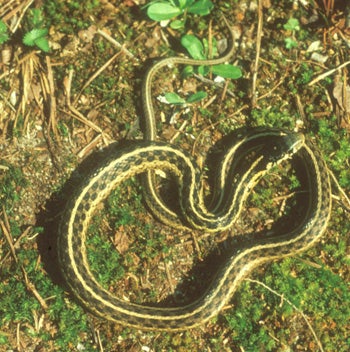SCIENTIFIC NAME:
Thamnophis sirtalis sirtalis
COMMON NAME:
Garden snake or gardener snake
STATUS:
Fairly common statewide. Frequently encountered, especially in northern Alabama. Lowest Conservation Concern.
DESCRIPTION:
Eastern garter snakes are small to medium sized. Adult garter snakes are usually between 18-26 inches long, but may reach 36 inches in length. Newborn garter snakes are typically between 5-9 inches long. The garter snake’s coloration varies greatly across its geographic range. Typically, these snakes have three yellow stripes running down the length of their backs, but the stripes are sometimes reddish and sometimes closer to white than yellow. These stripes are what earned the garter snake its name because people described the stripes as resembling those on a garter. Additionally, garter snakes usually have a series of blotchy spots between the stripes on its back. Both the pattern of the spots and their coloration can vary greatly.
DISTRIBUTION:
Eastern garter snakes are found from southern Ontario and Quebec in Canada, south to Florida, and westward to Minnesota, eastern Oklahoma and Texas. They are the most widely distributed snake in North America and are, in many areas, the snake most commonly encountered by people.
HABITAT:
Eastern garter snakes are found in a variety of habitats from marshes to hillsides and from drainage ditches to vacant lots and damp woodlands. They are found in both wet and dry areas with varying proximity to water and rivers. The nickname garden snake or gardener snake arose because of their common occurrence in gardens throughout their range.
FEEDING HABITS:
Eastern garter snakes, like all snakes, are carnivorous, feeding on a wide variety of prey. Their diet includes almost anything they are able to kill and swallow. Eastern garter snakes are very adaptable and often eat whatever opportunity allows. Adult garter snakes feed on insects, amphibians, small birds, fish, and small rodents. They also have been known to eat small eggs. Juveniles feed on slugs, earthworms, insects, spiders, tadpoles, and other small creatures they encounter.
LIFE HISTORY AND ECOLOGY:
Eastern garter snakes go through a hibernation-like process called brumation during the winter, often doing so in large communal dens. Mating takes place soon after emerging from hibernation in the early spring, usually from late March to early May. Eastern garter snakes have a very complex system of pheromonal communication. The system is used to locate other snakes during the breeding season. Males try to mate with as many females as possible. “Snake balls” are very common with up to 100 males simultaneously trying to mate with a single female. After breeding, females leave the mating area to find a place to give birth. Eastern garter snakes are ovoviviparous, which means that they give birth to live young. Gestation takes two to three months, with up to 50 young produced in a single litter. The young snakes are independent at birth, and have a maximum life expectancy of 10 years.
REFERENCES:
Conant, R., J. Collins. 1991. Peterson Field Guides: Reptiles and Amphibians of
Eastern/Central North America. Boston: Houghton Mifflin Co.
AUTHOR:
Kevin Pugh, Wildlife Biologist, Alabama Division of Wildlife and Freshwater Fisheries






